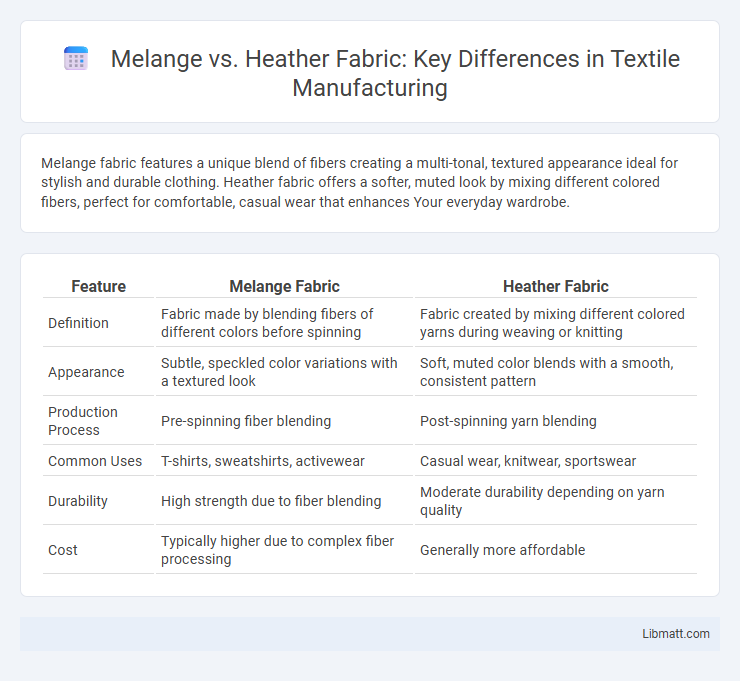Melange fabric features a unique blend of fibers creating a multi-tonal, textured appearance ideal for stylish and durable clothing. Heather fabric offers a softer, muted look by mixing different colored fibers, perfect for comfortable, casual wear that enhances Your everyday wardrobe.
Table of Comparison
| Feature | Melange Fabric | Heather Fabric |
|---|---|---|
| Definition | Fabric made by blending fibers of different colors before spinning | Fabric created by mixing different colored yarns during weaving or knitting |
| Appearance | Subtle, speckled color variations with a textured look | Soft, muted color blends with a smooth, consistent pattern |
| Production Process | Pre-spinning fiber blending | Post-spinning yarn blending |
| Common Uses | T-shirts, sweatshirts, activewear | Casual wear, knitwear, sportswear |
| Durability | High strength due to fiber blending | Moderate durability depending on yarn quality |
| Cost | Typically higher due to complex fiber processing | Generally more affordable |
Introduction to Melange and Heather Fabrics
Melange fabric is created by blending fibers of different colors, producing a subtle mix of shades that gives a textured, multi-dimensional appearance. Heather fabric also features a mix of colors but is typically made by blending dyed yarns before weaving or knitting, resulting in a softer, speckled look. Both Melange and Heather fabrics are popular in fashion and activewear for their distinctive visual texture and comfort properties.
Definition and Origin of Melange Fabric
Melange fabric is a textile made by blending different colored fibers together before spinning, creating a unique, speckled appearance with subtle color variations. Originating from traditional European weaving techniques, melange has become popular for its casual yet sophisticated look in apparel and home textiles. This fabric is often used in knitted garments and activewear due to its soft texture and aesthetic versatility.
What is Heather Fabric?
Heather fabric is characterized by its interwoven yarns of mixed colors, creating a soft, muted, and speckled appearance that adds depth and texture to textiles. It is typically made by blending different fibers or dyed threads before weaving or knitting, resulting in durable and visually appealing materials commonly used in casual wear and activewear. This fabric offers a unique aesthetic that distinguishes it from Melange fabric, which involves a more intricate technique of mixing fibers at the spinning stage.
Manufacturing Process: Melange vs Heather
Melange fabric is produced by blending different colored fibers before the spinning process, resulting in a unique, multi-tonal yarn with a subtle texture. Heather fabric, on the other hand, is created by mixing two or more differently colored yarns during knitting or weaving, which produces a soft, speckled appearance. Understanding these manufacturing differences helps you choose the right fabric based on texture and color depth for your apparel needs.
Fiber Content and Material Composition
Melange fabric is typically created by blending different colored fibers, often combining natural fibers like cotton, wool, or silk with synthetic fibers such as polyester for enhanced texture and visual depth. Heather fabric, on the other hand, is produced by mixing fibers of different colors and materials at the yarn stage, usually combining cotton with polyester or rayon to achieve a muted, speckled appearance. Understanding the fiber content and composition of these fabrics can help you choose the right material for comfort, durability, and style preferences.
Distinctive Visual Differences
Melange fabric features a unique interwoven pattern created by blending fibers of different colors, producing a subtle, textured look with varied shades throughout the material. Heather fabric displays a softer, speckled appearance achieved by mixing fibers with different tones, resulting in a more uniform, mottled effect. The key distinction lies in Melange's intricate, multi-tonal depth versus Heather's gentle, consistent color variation.
Performance and Comfort Comparison
Melange fabric offers superior moisture-wicking and breathability, making it ideal for activewear and performance gear where temperature regulation is crucial. Heather fabric provides a softer texture and enhanced comfort, favoring casual wear with its cozy feel and durability. Your choice between Melange and Heather should consider the balance between performance needs and everyday comfort.
Popular Uses in Fashion and Apparel
Melange fabric, characterized by its mixed yarn colors, is popular in casual wear such as t-shirts, sweatshirts, and activewear due to its textured appearance and comfortable feel. Heather fabric, known for its soft, blended fibers, is commonly used in knitwear, hoodies, and loungewear, offering a subtle, mottled look that enhances style and comfort. Your choice between Melange and Heather depends on the desired aesthetic and fabric texture for casual or athleisure fashion.
Care and Maintenance Tips
Melange fabric requires gentle washing in cold water and air drying to preserve its unique color blending and texture. Heather fabric benefits from machine washing on a delicate cycle and low heat drying, maintaining its soft, mixed-fiber appearance. To extend the life of Your garments, always avoid bleach and iron on low settings to prevent damage to both Melange and Heather materials.
Which Fabric to Choose: Melange or Heather?
Choosing between Melange and Heather fabric depends on your desired texture and appearance; Melange offers a mixed, soft color effect created by blending different fibers, while Heather provides a more uniform, subtly speckled look through interwoven yarns of varied hues. Your preference for durability and casual style may lean toward Melange, known for its unique, multi-dimensional patterns, whereas Heather suits those seeking classic, muted tones with a smooth finish. Evaluate your clothing needs--whether for activewear or everyday wear--to select the fabric that best aligns with your comfort and aesthetic preferences.
Melange vs Heather fabric Infographic

 libmatt.com
libmatt.com